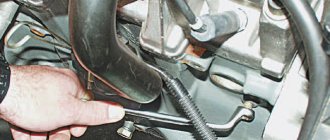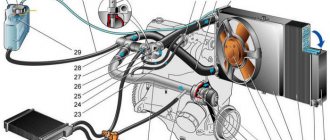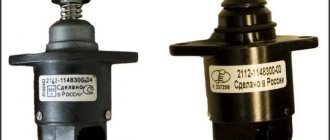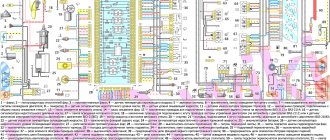Which thermostat is better for VAZ 2114
FAQ How to choose a thermostat, and which thermostat to buy.
How to choose a thermostat, and which thermostat to buy.
Buying a thermostat
- this is a question even more pressing than its verification. And you can get burned when choosing a thermostat as easily as you would get burned on a hot kettle.
The parts seller says:
There is no point in lying to our clients, showing what kind of specialists we are and how we understand our business. Therefore, keep it clean.
When choosing a thermostat, 70 percent of drivers say: “give me the cheapest one.” Only the remaining 30 percent tries to touch the rubber seals, press on the valve and pull the rod until it sticks. The difference between the two halves is big. If the other half is still somehow trying to choose a quality item, but out of ignorance is trying to push through a rod curled into a spring, which reacts only to changes in temperature, and then asks why it doesn’t work, then there is no point in explaining anything to the other half and all that remains is to send a person to the fair, where he is more welcome than ever.
Therefore, the remaining 30% half may benefit from the following information.
What to pay attention to when purchasing:
The first, and perhaps the last, is the metal of the thermostat housing. The main problem is corrosion. Buy a Chinese thermostat once and see how within a year it is covered with rust, and the shine that looked like stainless steel turns out to be not stainless steel at all. Choose a thermostat with a stainless steel or brass body. These thermostats will not corrode for many years.
There are no other selection criteria anymore. Not a single hologram or sticker on the packaging of the most expensive thermostat says anything other than that it exists. Do not press the valve. It will only work at the set temperature. This is not a spring. This is a rod made of a special material that is curled in a spiral.
You won’t be able to check the thermostat for functionality at the store counter. Therefore, check it before installing it in hot water, at least for smooth opening and closing. Thus, make sure that the thermostat rod does not jam and that everything is in order with it.
It happens that the engine overheats or, conversely, in winter it is impossible to warm up the car interior to normal temperature. All these are consequences of a malfunction of the thermostat, which is responsible for the circulation of antifreeze in the engine cooling system.
The thermostat ensures quick warm-up of the car at low temperatures and also prevents the engine from overheating. A thermostat malfunction can be detected by looking at the instrument panel. The coolant temperature sensor arrow will be in the red, unacceptable zone. In winter, you may notice that the car interior does not warm up well.
In the first case, the thermostat is always closed and the coolant circulates in a small circle. In this case, only a small part of the heat from the engine is “thrown out” into the environment. Therefore, the engine may overheat. In the second case, the thermostat is constantly open and the engine does not have enough of its own heat to warm up to operating temperature. Increased fuel consumption is possible here.
If you suspect that the thermostat is faulty, then you should remove it. First, drain the coolant and then remove the thermostat. In different models, the thermostat is removed in different ways, so we will not dwell on this.
So, the thermostat has been removed. Now you need to remove all scale and dirt from it and clean the small hole in the valve. The thermostat is checked as follows. We put some container with water (for example, a saucepan) on the electric stove and heat it (we also need a thermometer with a scale of more than 100 degrees). The thermostat must be checked according to two criteria: valve opening moment and dimensions. The first criterion is the temperature at which the thermostat valve opens. Most often, the temperature is indicated on the thermostat housing and ranges from approximately 81-85 degrees (VAZ) to 92-93 (some foreign cars, as well as thermostats of modern domestic engines).
Sometimes you can check the thermostat by size: before heating and after. Use a caliper - measure the distances between two points before and after heating. Most often, the difference in distances should not be less than 7 mm.
When the thermostat has cooled down, you need to check whether the valve is completely closed. If a malfunction is detected, the thermostat can only be replaced; it cannot be repaired.
Lada 2114 (16valve wells filled) › Logbook › THERMOSTATS. Quality of spare parts
Hi all!
This post will focus on thermostats. My car has covered 53,000 km in such a short mileage. I replaced a sufficient number of them.
At first, the new machine worked properly as expected. It warmed up quickly, the temperature remained stable in all modes, 87-88 degrees. The thermostat was factory THOMSON-AUTO 21082. But gradually the operating temperature decreased, the warm-up time increased, my feet froze in winter, I inserted all sorts of cardboard under the radiator. etc. It got to the point where the car didn’t reach more than 78 degrees. And at 24,000 km. I changed it for a new one. I installed PRAMO 21082 Lid and thermoelement. The body remains factory.
After replacement, everything was restored. Temperature 90, warming up quickly. Both in winter and in summer. The stove heated well. He left me for a year and a half, and last winter, the situation began to repeat itself. The warm-up time increased, the operating temperature decreased slightly. Up to 84 - 85 degrees. In winter this is not enough and it is noticeably cold in the cabin. A 16 valve engine should not operate at this temperature. Fuel consumption increases, wear increases. You wait a long time for it to warm up. But if you turn on the heater fan at first speed, the car takes forever to warm up, and the operating temperature drops another 2 degrees.
Well, I think it needs to be changed. I went to the market, bought a new one, the seller said, SALUTE is good, there will be no problems. I quickly installed it and added antifreeze. I started monitoring my temperature. As it turned out, it only gains 83 degrees even worse than the old one. It's also cold in the cabin. I drove with it for two weeks and threw it away.
Yeah. I no longer like this picture. Who knows what to put here. I went to Bibi and looked at what was there. Phenox, Luzar, finord. I bought Luzar 21082. I didn’t install it right away, I cooked it in a saucepan with a thermometer to check the opening temperature and, if anything, return it to the store.
Opened at about 85 degrees. As it is written. I installed it. I went for a ride. It keeps the temperature at 85-86. With the engine on 84. I skated on it this winter. But again with cardboard and a closed grille. And with the onset of warmer weather, I began to dislike the fact that in the heat of the city, in traffic jams, the cooling fan often began to turn on and slowly drop the temperature. It’s easier to say this: It’s fine on the highway, it holds 84 degrees. But as soon as the temperature exceeds 90-92 degrees in the city, a different picture begins. The machine starts working at 95-99 degrees. The fan cools the motor slowly. I do not like it. How to say then. In cold weather it is cold, and in hot weather it is hot. Poorly configured and misses. Doesn't work exactly.
This whole story with the cooling system is starting to piss me off. I’m already tired of draining, filling, unscrewing. I wanted to put back Pramo, which I removed. For summer it is normal, but when winter comes it will start to become underheated again.
In short, I went to LIPETSK-LADA. I took the factory thermostat, which is installed on the assembly line. THOMSON-AUTO 21082, which was on my car from the very beginning. Now I decided to change it together, with the body. I thought maybe there was something wrong in the housing itself, why the thermostats were working so unstable and letting everything go in a big circle.
When replacing the thermostat, you do not need to drain all the fluid from the engine. I did the following. I took a canister from the washer fluid, cut it and put it on the box, of course it’s a bit cramped in there, we do everything carefully so as not to spill the antifreeze. Afterwards, using a syringe, I poured all the antifreeze that had drained into a canister. While I was unscrewing it, it settled and if there were any specks, they settled to the bottom. After installation, fill everything back in.
Well, I've done everything and installed it. I started the car and started watching. And I understood right away. That everything is fine. Warming up is quick and the temperature stays the same. In all modes. And for the fan to work, you need to stand idle for a very long time. In short, it works as it should. But after such a f*ck with these thermostats, the question still worries me. How long will this one last?
The next day I went to Lipetsk to the university for an exam. On the way, I monitored the temperature and drove in different modes. The temperature remains constantly at 90 degrees. Its limits do not go beyond the permissible limits. 89,90,91,92. Everything is stable. The fan on valve motors turns on at 102 degrees. From this temperature it quickly drops to 94. And not like Luzar worked for me. The fan was spinning every now and then.
The temperature under load also does not change.
At a speed close to maximum, in 4th gear, the temperature is the same. The wind does not cool the engine.
I hope this thermostat will come in handy. By the way, during operations to remove pipes and unscrew clamps, change the factory clamps to NORMA clamps. factory ones, cutting pipes. Unscrew and tighten it a couple of times, the third time you will have to change the pipe.
Well, that’s all, the quality of the spare parts is of course crap, it’s hard to believe that the same thing happens on foreign cars.
We choose which thermostat is better to install on the injection 8 valve VAZ-2114
The engine temperature affects not only the temperature of the heater, and this, unfortunately, is what worries the owners of Togliatti cars primarily. This does not speak of their shortsightedness, but of the imperfection of the heater, but today we are not talking about it. The temperature regime of the engine depends on one simple but very important device called a thermostat . When we learn more about the modifications of VAZ devices, the question of which thermostat is better to install on the injection VAZ-2114 will automatically disappear.
FakeHeader
Comments 43
But there are no original ones for Toyota for 88. Only for 82 or TAMA?
I decided to do this myself in the winter of 88 and in the summer of 82
I installed a new TAMA at 88 in Caribe, and changed the fluid at the same time, in the winter I burned my hands with the heat from the stove, and in the summer there were no problems. Installed TAMA. But I would put the original on a Lexus, I’d already put it in the cart.
Question for the experts, I replaced the antifreeze, the thermostat at 82, removed the air, the stove heats only at 2. On long trips the heat is on the 1st and the lamb is half full. Where to dig?
Why do you need a thermostat?
We will not organize courses on eliminating automotive illiteracy, because every self-respecting driver knows that the thermostat directs the coolant either in a large circle (including the engine cooling radiator) or in a small circle (bypassing the radiator).
Thermostat for VAZ-2114 injector
The operating algorithm of the device depends on the thermodynamic valve, which closes one pipe in the thermostat and opens the other. Before changing the thermostat, it must be checked.
To refresh your memory of its structure, we have provided a diagram of the VAZ-2114 thermostat and attached it below.
Scheme of operation of the cooling system (thermostat)
As can be seen from the diagram, this is a simple device with a thermal valve, which, when a certain temperature is reached, is activated, thus directing the antifreeze in a small or large circle.
In most cases, it has three pipes - one inlet and two outlet . through which the coolant flows either directly from the pump into the heater and further through the cooling system, or into the radiator if its temperature has reached the required value. It is the temperature value at which the device operates that determines the use of the thermostat on a particular VAZ model, although there are still some nuances that specifically concern the VAZ-2114 injector.
Video about the operating principle
Operating principle of the cooling regulator
The function of the thermostat is to control the movement of the working fluid to maintain the engine temperature within the operating range. When turned off, the coolant moves along a small circuit, giving off heat only to the interior heating system.
When 87ºС is reached in the adjustment mechanism, the locking properties of the special heat-sensitive element holding the spring-loaded piston are reduced. With increasing heating, the strength of the protection decreases, and the rod opens the bypass valve to allow coolant to pass into a large circle with a mandatory visit to the large radiator for enhanced heat transfer.
When the operating temperature drops, the reverse process occurs in the control mechanism; as a result, the main valve spring returns the thermostat to the closed position. The stable operation of the protective element is the main factor for the optimal operation of the entire cooling system and the safe operation of the machine with an injector.
Types of VAZ thermostats and which one is better
Visually, even an experienced salesman cannot distinguish a kopek thermostat from a Niv one. Because the difference is inside them and in the location of the pipes. All Togliatti thermostats are made according to the ancient Fiat design - they are removed from the cylinder head into a separate unit and fixed to the pipes and hoses of the cooling system. Here are the main types of VAZ thermostats:
- All classic Zhigulis had a 2101 thermostat under the hood . which can be identified by the location of the pipes, they are turned opposite each other almost at a right angle. However, the most important difference is that the thermal operating conditions of rear-wheel drive Zhiguli engines required blocking the valve at 80 degrees and fully opening it at an antifreeze temperature of 95 degrees.
Exactly the same device was installed and is being installed on Niva . The only difference is that the angle between the pipes tends to 180 degrees.
Thermostat VAZ 21213, 21214 (Niva)
The eight thermostat is installed on all carburetor Samaras in their countless modifications. The difference with classic motors in terms of thermoregulation is that in thermostat 2108 the valve should operate seven degrees later. This happened due to the more advanced design of the combustion chamber, so until the antifreeze temperature reaches 87 degrees, the valve should be closed, and only at 102 degrees should it open.
Modern thermostats on the spare parts market are not distinguished by high accuracy and high quality workmanship, so after a series of tests the plant gave two degrees to the manufacturers. As a result, on boxes with thermostats for the entire Samara family, you can often see the number 85. Visually, the 2108 thermostat is distinguished by the presence of a thin pipe to remove possible air bubbles. The tenth VAZ family received exactly the same thermostat housing as on the classic, but in a mirror image. It does not have a small pipe for air outlet, since the design for the carburetor tens provided a separate tee, which greatly complicated the decoupling of the hoses under the hood. By the way, the figure-eight device is also perfect for carburetor tens; the only thing you need to do is tightly plug the small air hole.
Such thermostats have become the most popular, so when purchasing them, you should definitely look inside; there should be a curtain made of plastic or metal, which better redistributes the flow of liquid to the thermoelement. If it is not there, the valve response temperature can differ greatly (up to 10-15 degrees) from the nominal value, which leads to engine overheating. The thermostat of the 2112 family is designed specifically for injection VAZ engines . Actually, the thermostat doesn’t care what type of power system it is, it does its job and if the manufacturer is conscientious, the valve will always be closed up to a temperature of 85 degrees.
What is better than a thermostat with “ten”?
Of course, we are not talking about the models that were included in the first “ten” releases. The VAZ-2109 thermostat (carburetor) is very similar to the one that was installed in the first “ten” models. But now we are talking about more modern models. Their main advantage is that the number of clamps is reduced to a minimum. But the thermostat is not attached to the engine block using a short pipe. The housing is screwed to the engine block using two studs. The temperature sensor is screwed into the thermostat, therefore, the second hole must be plugged.
In addition, when installing the thermostat from “ten” to “nine”, it becomes possible to save a little, because you can only change the sensitive element. Passive benefits include freeing up space under the hood. The thermostat housing becomes five centimeters shorter, which makes it possible to easily reach, for example, the adjusting nuts of the clutch cable.
Which thermostat is better to install on the VAZ-2114
The difficulty in choosing a thermostat specifically for the VAZ-2114, and for any VAZ, is not even that we will not know its model. There are no problems in this regard; both the model and the valve response temperature are stamped on the bottom of the device. The problem is different - each of the manufacturers, and there are more than two dozen of them, supplies devices of completely different quality. They differ both in response temperature and resource.
Practice shows that the average thermostat must travel at least 120-150 thousand km before it goes on its final journey to scrap.
The price of a thermostat for a VAZ-2114 is from 150 to 400 rubles . The difference is palpable, as is the difference in quality. The public trusts more the native VAZ devices, which honestly work well over a hundred thousand.
Good reviews about Ween thermostats, made in Poland, warranty mileage of 150,000 km, as a rule, stand up. You definitely shouldn’t buy Chinese thermostats, there are conflicting reviews about Luzar thermostats (as well as radiators), other devices can either be successful or leak after 5 thousand miles.
Good luck with your choice and stable temperatures!
His love for cars began in childhood, when he began collecting model cars. I always helped my father with the repair of an old penny, where he gained his first experience. Today I am the owner of a small car maintenance and repair service. I try to keep up with the times, studying new technologies for diagnosing modern cars.
Purpose of the device
Thermostat for a VAZ-2114 car
Essentially, a thermostat is a large valve whose task is to allow (or, conversely, not to allow) coolant into the car radiator . When the car's engine has just started, it remains cold for some time, as does the coolant. During this period of time, the thermostat valve is closed, so that the coolant is directed in the so-called small circle. And when the engine temperature reaches 90°C, the valve in the device automatically opens and coolant begins to flow into the radiator. Thanks to this operating scheme, the engine temperature is kept at a constant level, and overheating is eliminated.
Installation process
Anyway, now is the second part of repairing the cooling system of the VAZ-2114 car. How to change the thermostat and install a new one? To do this, we will need a couple of minutes of free time and a small set of tools. Now all that remains is to install the newly purchased thermostat in the car. VAZ-2114 (replacement of this part should not be carried out without a special check) should first be diagnosed for the operability of parts of the cooling system. Before installation, the thermostat must be checked for suitability for use. To do this, boil a pan of water to 80 degrees Celsius and throw it there. At a temperature of 87 degrees, the mechanism rod should move out of the power element. If this does not work, most likely you received a defective thermostat. The VAZ-2114 (replacing this part with a defective one will not solve the problem with the cooling system) will simply boil, which will certainly reduce the life of the internal combustion engine. We only need a working thermostat.
And this part is installed in the same way as removal in reverse order. True, here you need to pay attention to several points. When installing, take a close look at the condition of the O-ring in the socket groove. If it is damaged or very deformed, it is best to replace it with a new one. Also, the sealing ring must have elastic properties.
Reasons for replacement
As mentioned above, the thermostat is a valve, and therefore it can get stuck open, closed, or in between. This is the main reason for replacing thermostats on the VAZ-2114, and each case of jamming of the device is dangerous in its own way.
- If the thermostat valve is stuck in the closed position, this will cause the engine to heat up very quickly (especially when the car is used in the summer), since the coolant will constantly circulate only in a small circle.
- If the valve is open all the time, another problem arises: the engine will take a very long time to warm up to operating temperature. And in thirty-degree frost it will be almost impossible to warm up the engine, since the liquid circulates in a large circle all the time and simply does not have time to warm up to the required temperature.
- If the valve is stuck in an intermediate position, this can lead to engine problems.
How to check the thermostat of a VAZ 2106 without removing it from the car
We start the engine. After a few minutes, we feel with our hand the hose that goes from the cylinder block to the upper part of the thermostat housing. If it is cold and the lower radiator hose is warm, it means that the valve of the large circle is stuck in the open position and the small one is closed.
The opposite situation. The engine has warmed up to operating temperature. We try to touch the upper and lower radiator hoses. If they and the radiator cells are cold, then the valve of the large circle is closed, and the small circle is open and jammed. A secondary sign of a malfunction in such a situation is that the radiator forced cooling fan does not turn on, if one is installed.
And the last option is to determine if the thermostat is malfunctioning - the engine has been running for several minutes, according to the sensor, its temperature has begun to rise, but has not yet reached the green zone. We put our hand on the radiator hoses and at the outlet of the cylinder block. If their temperature is the same, then the valves are in the middle position and antifreeze “flows” through both cooling circuits.
Having decided on possible breakdowns, you need to change the thermostat; we’ll talk about how to do this in the following articles. Good luck to everyone on the roads!
Video on the topic:
A visual demonstration of the operating principle of the thermostat:
Troubleshooting
Before changing the thermostat, you need to make sure that it is the one that is faulty. The ways to do this are listed below:
- The engine starts and warms up for 10 minutes. Then the hood of the car opens, and the hand is carefully brought first to the upper and then to the lower radiator pipe. If the thermostat is in order, these pipes will not burn your hand and their temperature will be approximately the same. If the temperature of the pipes differs so much that it can be felt by a simple touch, then the thermostat is faulty.
- The engine starts, after which the hood immediately opens and the hand is brought to the upper radiator pipe. When the thermostat is working properly, this pipe remains cold until the engine reaches operating temperature, that is, about 10-15 minutes (in the warm season). After this time, the pipe heats up very quickly and noticeably. If this does not happen, the thermostat is faulty.
- And finally, the most time-consuming diagnostic method: the device is removed, placed in a container with water and a thermometer, after which the water is heated until the valve in the thermostat clicks. The temperature at which the valve operates is detected and based on it, conclusions are drawn about the operability of the device (in a working thermostat, the valve operates at a temperature of 90-95°C).
Video
This video contains useful information on how to check thermostats for quality.
How to check the thermostat yourself.
Thermostats for VAZ 2101-2107.
The thermostat is one of the most important components of the engine cooling system, allowing it to warm up a cold engine in a short amount of time until it reaches an operating temperature of 90°C and significantly reduces wear on the latter.
What is a thermostat in a car
As a rule, the thermostat is placed near the radiator. The design is equipped with a return spring, a heat-sensitive valve, and a solid filler. The pipes are connected so that 2 circles are used for cooling: the large one covers the radiator, and the small one covers the engine. After the engine starts, the coolant begins to flow and heats up, which ensures the fastest warm-up. When the coolant temperature reaches 90°C, the temperature-sensitive element opens the valve. The liquid enters the radiator, which ensures effective cooling, and the warmed-up engine keeps the temperature at normal levels.
Thermostats installed by the factory on the VAZ 2114 are not always of the proper quality, which is why most drivers, when given the opportunity, try to replace them with foreign analogues.
A huge mistake is made by those who, in the hope of saving on cost, decide to purchase and install Chinese-made thermostats. The latter soon fail and require replacement even faster.
Where is the thermostat located
On injection-type engines, the thermostat is located under the air filter, and on carburetor engines it is in the same place, except that the filter housing itself is slightly shifted on older models of the VAZ 2114-2115 family, which makes the removal procedure much easier.
There is no need to remove the housing; the high-voltage wires are simply disconnected and the required component of the cooling system can be dismantled. On injection models, after removing the filter housing, the thermostat will be visible. The battery on the right side can be considered a reference point.
When does a VAZ 2114 thermostat need to be replaced?
An indicator of wear may be improper valve operation. In some cases, the coolant begins to circulate in a large circle, as a result of which the car begins to quickly heat up, which is very little noticeable in the summer - this is the main problem. In winter, on the contrary, the car warms up very poorly. In these cases, the thermostat valve is completely open and does not close. The opposite case is when the valve is completely closed and the liquid begins to circulate in a small circle, the car begins to quickly heat up, and when driving in dense city traffic with traffic jams or during long stops, the engine temperature even reaches critical levels.
It is a little less common for the valve to open to the middle, while the car warms up in cold weather a little slower than normal, and in warm weather the temperature indicator needle can gradually reach a critical point. All these signs indicate a malfunction of the thermoelement.
There are cases when both the thermostat and the cooling fan are faulty. The liquid will flow only in a small circle, which can lead to rapid overheating of the engine and even damage the cylinder head. Then it will no longer be possible to do without major repairs.
If the temperature of the engine suddenly raises suspicions, or rather the engine takes a long time to heat up or too quickly, you can check the operation of the thermostat without dismantling it by doing the following:
- you should start the engine and let it warm up to a temperature of 87-92 ° C;
- at the moment of warming up, when the engine is still cold, touch the lower pipe next to the thermostat - it should be cold all the time until the engine warms up to operating temperature;
- When the engine finally warms up, the lower hose will begin to heat up. If the hose heats up ahead of time, or if the hose does not heat up even when the engine reaches operating temperature, this means that immediate replacement of the thermoelement is necessary.
Which thermostat to choose
To answer this question, it is important to understand one thing: saving on this device is strictly not recommended. A faulty thermostat leads to engine overheating. And overheating entails a lot of problems, the elimination of which can be very expensive. There are 2 brands of thermostats for the VAZ-2114, proven over the years, the quality of which car owners always speak well of:
- LUZAR (Lugansk Automobile Radiator Plant).
Thermostat for VAZ 2114 from LUZAR - WEEN (Poland).
Polish thermostat from WEEN
It is strongly not recommended to buy Chinese-made thermostats for the VAZ-2114 (in particular, BAUTLER); you should also refrain from purchasing devices from PRAMO (Russia, Vladimir), despite the fact that Polish thermoelements are installed there. Both of these brands, although they work, are not durable.
Sequencing
- Using a 13 key, unscrew the air filter.
- Unscrew 2 bolts and 1 nut on the radiator. Under one of the bolts there is a hole through which the coolant is drained into a container placed in advance under the radiator.
Drain bolt on the radiator for draining antifreeze - The connector located on the recirculation valve filter housing is removed. Then the valve itself is removed and carefully moved to the side along with all the tubes located next to it. The connector from the air flow sensor is also removed, the clamp on it is loosened, and then the air supply hose is removed.
All hoses have been removed from the recirculation filter housing and it is ready for removal. - After these operations, the filter is easily removed and access to the thermostat is opened.
- Use a 12 wrench to unscrew the nut on the top of the thermostat (there is only one there). After this, the ground wire is removed and the stud and the lower nut on the device are unscrewed with a 13mm wrench.
- After this, the thermostat is removed from the socket (this is done by slightly shaking the device, and if this does not help, the thermostat is pryed off with a screwdriver).
The thermostat is carefully removed from the socket - Before installing a new thermostat, the socket is thoroughly wiped off from drops of coolant and other contaminants, after which a thin layer of sealant is applied (the sealant must be allowed to dry for at least 5 minutes before installing the device).
- The new thermostat is installed in its original place, after which all components of the vehicle’s cooling system are reassembled.











